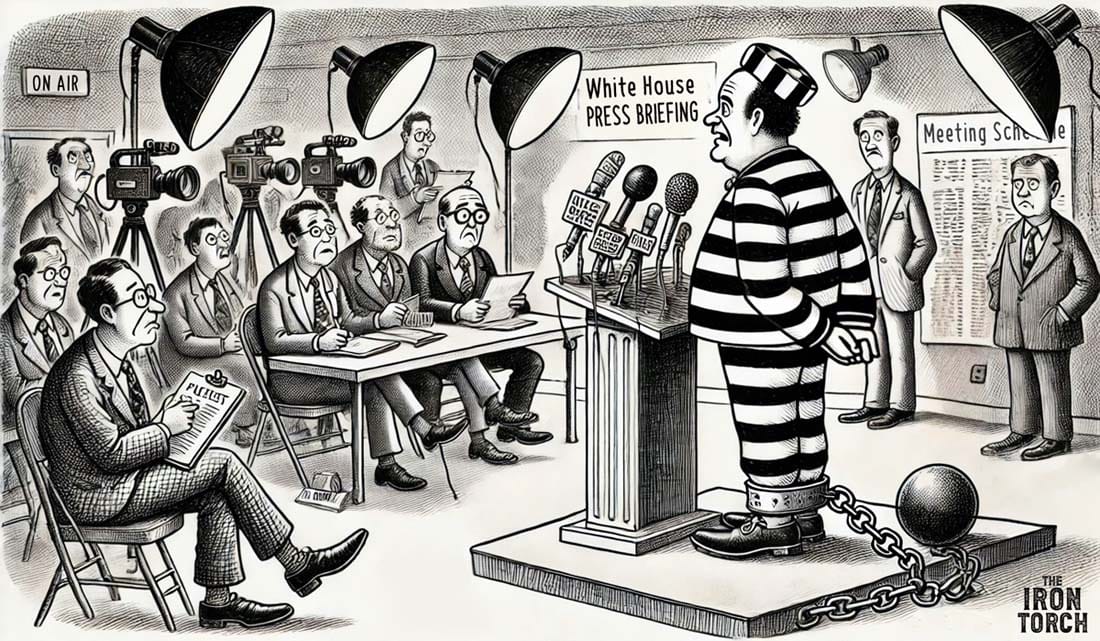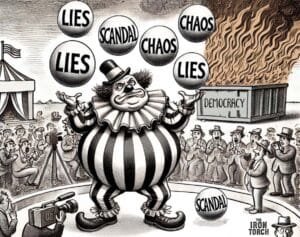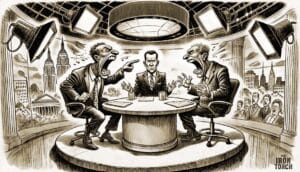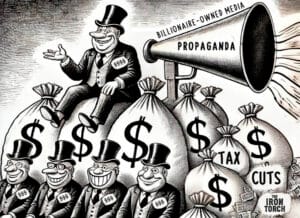Have you noticed how quickly the media normalizes criminal behavior, especially when it involves the Republican party?
Remember when a president pressuring election officials to alter vote counts would have derailed a political career? Yet, Trump’s recorded call with Georgia Secretary of State Brad Raffensperger, in which he requested “11,780 votes,” briefly made headlines before fading into just another item in the relentless news cycle, sandwiched between celebrity gossip and weather updates. It took a criminal indictment years later to resurface the story.
From Constitutional Crisis to Horse Race Coverage
The media’s tendency to frame criminal behavior as ‘politics as usual’ has dangerously dulled our collective moral compass.
Here’s another stark example: In 2019, Trump attempted to withhold congressionally approved military aid to Ukraine in order to pressure President Zelensky into investigating his expected 2020 rival, Joe Biden. This was a textbook abuse of power that our founders specifically feared.
However, instead of emphasizing the unprecedented nature of this event, many outlets ultimately defaulted to familiar “both sides” political coverage. Democrats decried Trump’s pressure campaign and breach of national security interests. Republicans accused Joe Biden of misconduct involving Ukraine during his tenure as Vice President under the Obama administration. The media normalized a constitutional crisis into yet another partisan squabble. This is the journalistic equivalent of reporting on a bank robbery by focusing on the disagreement between the robber and the bank, instead of the criminal actions of the robber.
The 'Palace Intrigue' of Impeachment
Despite the media’s lackluster coverage of the Zelensky call, Trump’s conduct ultimately led to his first impeachment. The House Intelligence Committee, led by Chairman Adam Schiff, investigated the claims and conducted hearings.
What got lost? The fundamental threat to democratic norms. The precedent being set. The actual evidence.
From Political Story to Public Spectacle
It took the dramatic format of televised Congressional hearings to cut through the noise. House Democrats, recognizing how media attention had shifted away from the substance of Trump’s actions, structured the impeachment hearings as must-watch television. Through carefully planned testimony and compelling witnesses, they forced media outlets to focus on the actual evidence of presidential misconduct rather than just the political horse race.
This reveals a troubling reality about our modern media landscape: Sometimes the only way to get serious misconduct covered as serious misconduct is to package it as compelling theater. Even then, many outlets quickly reverted to analyzing the hearings’ impact on polling numbers and other political metrics, rather than revelations about threats to democratic governance.
The Dangerous Dance of Media Normalization
Fast forward to 2024, and the media normalization of dangerous behavior reached new heights after Donald Trump won the presidency for a second term. Despite his campaign’s openly illiberal promises—mass deportations, weaponizing the Justice Department to target his enemies, and restructuring the government to consolidate personal power—many media outlets swiftly downplayed the existential threat his policies posed. Instead of treating his win as a crisis for democracy, they quickly shifted focus to blaming Democrats for their loss and speculating on his cabinet picks, as though he were just another conventional president.
This eagerness to return to “business as usual” ignored urgent warnings from former insiders, who publicly described Trump as a fascist at his core. It was a chilling reminder of how the press, eager to maintain access and avoid accusations of bias, can fail to confront autocracy head-on, inadvertently aiding in its rise. By prioritizing palace intrigue over substance, the media once again danced perilously close to normalizing the abnormal.
The Scandal Fatigue Strategy
Why doesn’t the media hold criminal politicians, like Donald Trump, to account? There are probably many reasons, but here’s a pattern worth noting: When scandals come fast and furiously, even the extraordinary starts feeling ordinary. Consider this small sampling of Trump scandals:
- 26 sexual misconduct allegations
- Egregious abuse of pardon power
- Witness intimidation claims
- Criminal obstruction of justice
- Criminal attempt to overturn election results
- Classified documents found in unauthorized storage
- Falsified tax records
- Financial fraud allegations
- 34 felony indictments
Each of these would have ended a political career, never mind a presidential run, in another era. But in today’s media environment, they become a blur of “Trump’s latest controversy.”
Why This Matters
As we watch a brazen, lawless president repeatedly escape punishment for crimes that would imprison anyone else, many of us feel demoralized, and it’s tempting to withdraw. However, we must remember the stakes involved.
When we let media outlets treat criminal conduct, blatant norm-breaking, and constitutional crises as routine political theater, it accelerates the backsliding of our democracy. Normalization desensitizes the public to serious breaches of trust and creates false equivalencies between typical partisan disagreements and criminal or illiberal behavior.
In other words, if every scandal is reduced to just another day’s political entertainment, it becomes impossible to recognize real threats to democracy; this is how authoritarian regimes take root and grow.
Breaking the Cycle
So what can we do? Here are practical steps for both the public and journalists:
For the Public:
- Don’t disengage; apathy lets authoritarians consolidate power.
- Watch for headlines that minimize serious misconduct.
- Notice when coverage focuses on horse-race politics instead of substance.
- Support outlets that maintain perspective on the gravity of norm-breaking.
- Share articles that properly contextualize threats to democracy.
For Journalists:
- Resist the urge to frame everything as a partisan conflict.
- Separate the signal from the noise; hone in on the most consequential acts.
- Maintain consistent standards for what constitutes normal political behavior.
- Provide historical context for unprecedented actions.
- Clearly distinguish between policy disagreements and democratic breaches.
The Path Forward
Democracy relies on a shared understanding of what’s normal and what’s not. When the media blurs these lines, it becomes harder to defend democratic institutions. By recognizing these patterns, we can see through the media’s sane-washed reporting, demand better coverage, and maintain our grip on reality.
This is part 2 of 4 in the series: Media’s Role in Democratic Decline. Up next is 3-Billionaire-Owned Media: How the Rich Control What You Think.
(Other posts in this series include 1-Crisis of Truth in Media and 4-The War on Truth)





Pingback: The Crisis of Truth in Media: How Ratings Rule & Truth Suffers